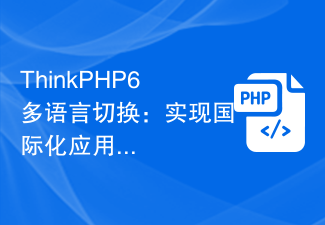 Web Front-end
Web Front-end Vue.js
Vue.js How to implement page internationalization and multi-language switching in Vue technology development
How to implement page internationalization and multi-language switching in Vue technology development
How to implement page internationalization and multi-language switching in Vue technology development
Introduction:
With the development of globalization, more and more applications Multi-language support is required. In the development of Vue technology, how to implement page internationalization and multi-language switching has become particularly important. This article will introduce how to use the Vue-i18n plug-in to implement page internationalization and multi-language switching, and provide specific code examples to help readers better understand.
1. Introduction to Vue-i18n
Vue-i18n is an internationalization plug-in for Vue.js, which allows us to easily implement multi-language switching and page internationalization. It provides a translation function and a translation directive that allow us to use different languages in templates and scripts.
2. Use Vue-i18n to achieve page internationalization
-
Install Vue-i18n
First, install Vue-i18n in the project, which can be installed through npm :npm install vue-i18n
-
Create language pack file
Create a locales directory in the src directory, and create a json file in it to store the translated text of each language. For example, create a zh.json file to store Chinese translated text:// zh.json { "hello": "你好", "welcome": "欢迎来到我的网站" } -
Configure Vue-i18n
Configure Vue-i18n in the main.js file and change the language The package file imports and configures the Vue-i18n instance:// main.js import Vue from 'vue'; import VueI18n from 'vue-i18n'; import zh from './locales/zh.json'; Vue.use(VueI18n); const i18n = new VueI18n({ locale: 'zh', messages: { zh } }); new Vue({ i18n, render: h => h(App) }).$mount('#app'); -
Use the translation function in the template
In the template of the Vue component, you can use the translation function $t provided by Vue-i18n to translate. For example, in a HelloWorld component:<template> <div> <p>{{ $t('hello') }}</p> <p>{{ $t('welcome') }}</p> </div> </template> -
Switch language
Vue-i18n also provides a method for switching language $locale, which can realize the page change by switching different locales. Multi-language switching. For example, provide a drop-down menu in the component to switch languages:<template> <div> <select v-model="$i18n.locale"> <option value="zh">中文</option> <option value="en">English</option> </select> <p>{{ $t('hello') }}</p> <p>{{ $t('welcome') }}</p> </div> </template>
3. Summary
This article introduces how to use Vue-i18n to achieve page internationalization and multi-language switch. By installing the Vue-i18n plug-in, creating a language pack file, configuring the Vue-i18n instance, and then using the translation function $t in the template to achieve internationalization and multi-language switching. In the component, you can switch the language by switching the locale. I hope this article can help readers better understand how to implement page internationalization and multi-language switching in Vue technology development.
(Total word count: 560 words)
The above is the detailed content of How to implement page internationalization and multi-language switching in Vue technology development. For more information, please follow other related articles on the PHP Chinese website!
 PHP开发指南:实现简单的多语言切换功能Jul 01, 2023 pm 08:58 PM
PHP开发指南:实现简单的多语言切换功能Jul 01, 2023 pm 08:58 PMPHP开发指南:实现简单的多语言切换功能简介:随着互联网的发展,越来越多的网站和应用程序需要支持多语言功能。在Web开发中,实现多语言切换功能是一项非常重要的任务。本文将介绍如何使用PHP来实现简单的多语言切换功能,并提供代码示例供开发者参考。一、准备工作在开始实现多语言切换功能之前,我们需要做一些准备工作。首先,我们需要确定支持的语言种类,并创建对应的语言
 比特币永续合约平台软件BTC永续合约交易平台大全Feb 03, 2024 am 08:57 AM
比特币永续合约平台软件BTC永续合约交易平台大全Feb 03, 2024 am 08:57 AM比特币永续合约平台软件有binance,CryptoGro,UniswapV3,比特pro,AMGEX,dYdX,PKEX,币系,BearBit,Deepcoin。各平台的相关介绍如下,感兴趣的朋友可以来看看。BTC永续合约交易所大全1、binance:很多投资者都熟悉并使用Binance官网交易所。成立于2013年,Binance官网提供了法币交易、币币交易和合约交易等服务。经过8年的发展,Binance官网仍屹立在虚拟货币交易所前十的位置,证明其在区块链交易领域的持续实力。2、CryptoG
 ThinkPHP6多语言切换:实现国际化应用Aug 25, 2023 pm 08:31 PM
ThinkPHP6多语言切换:实现国际化应用Aug 25, 2023 pm 08:31 PMThinkPHP6多语言切换:实现国际化应用随着互联网的快速发展和全球化的进程,越来越多的网站和应用程序需要支持多语言功能,以满足不同国家和地区用户的需求。在使用ThinkPHP6开发Web应用时,实现多语言切换是一项重要的任务,本文将介绍如何在ThinkPHP6中实现国际化应用,为用户提供便捷的多语言体验。为什么需要多语言切换?在全球化背景下,用户使用互联
 笔记本电脑键盘的使用和按键功能Mar 21, 2024 am 09:40 AM
笔记本电脑键盘的使用和按键功能Mar 21, 2024 am 09:40 AM笔记本电脑键盘有哪些功能1、F1:如果你处在一个选定的程序中而需要帮助,那么请按下F1。除此之外,还可以调节成静音。F2:如果在资源管理器中选定了一个文件或文件夹,按下F2则会对这个选定的文件或文件夹重命名。还可以降低音量。2、键盘分为四个区:功能键区、主键盘区、状态指示区、控住键区。键盘中单字字母的按键是用来打字的。shift和ctrl两个键也就是红色圈内的两个按键同时按时调理拼音键式的。当你同时按时它会出现:拼音、字母、五字笔。3、在键盘中间数量最多的按键区,包括数字键,字母键和符号键,控制
 Vue中如何使用路由实现国际化的多语言切换?Jul 22, 2023 pm 12:17 PM
Vue中如何使用路由实现国际化的多语言切换?Jul 22, 2023 pm 12:17 PMVue中如何使用路由实现国际化的多语言切换?在开发多语言网站时,我们的一个重要需求是能够根据用户选择的语言,实现网站内容的切换。Vue.js是一款流行的JavaScript框架,通过使用VueRouter插件,我们可以很方便地实现路由功能。在本文中,我将介绍如何使用路由实现Vue中的国际化多语言切换。首先,我们需要安装VueRouter插件。可以通过np
 如何利用Vue表单处理实现多语言切换Aug 10, 2023 pm 02:29 PM
如何利用Vue表单处理实现多语言切换Aug 10, 2023 pm 02:29 PM如何利用Vue表单处理实现多语言切换在现代的Web开发中,多语言支持已经成为一个必不可少的功能。通过支持多语言,我们可以服务不同地域的用户,提供更好的用户体验。在Vue中,利用表单处理实现多语言切换是一种常见的做法。本文将介绍如何利用Vue表单处理实现多语言切换,并提供代码示例。首先,我们要创建一个LanguageSwitcher组件,该组件用来切换应用程序
 Flash中心怎么设置语言版本-Flash中心设置语言版本的方法Mar 04, 2024 pm 04:13 PM
Flash中心怎么设置语言版本-Flash中心设置语言版本的方法Mar 04, 2024 pm 04:13 PM今日为各位带来的内容是关于Flash中心软件的,你们晓得Flash中心怎么设置语言版本吗?接下来,小编就为各位讲述了Flash中心设置语言版本的方法,感兴趣的用户快来下文看看吧首先在电脑上打开Flash中心,如图所示。点击右上角菜单图形按钮,如图所示。点击列表中设置选项,进入设置面板。然后在设置面板中点击常规设置,如图所示。最后点击语言版本选项即可。
 如何在uniapp中使用多语言切换技术实现多语言支持Oct 24, 2023 pm 12:57 PM
如何在uniapp中使用多语言切换技术实现多语言支持Oct 24, 2023 pm 12:57 PM如何在uniapp中使用多语言切换技术实现多语言支持引言:在移动应用中,为了满足不同用户的语言需求,实现多语言支持是很常见的需求。通过使用uniapp提供的多语言切换技术,我们可以轻松地实现应用的多语言支持。本文将介绍如何在uniapp中使用多语言切换技术实现多语言支持,并提供具体的代码示例。一、准备工作:在开始之前,我们需要确保已经安装好uniapp开发环


Hot AI Tools

Undresser.AI Undress
AI-powered app for creating realistic nude photos

AI Clothes Remover
Online AI tool for removing clothes from photos.

Undress AI Tool
Undress images for free

Clothoff.io
AI clothes remover

AI Hentai Generator
Generate AI Hentai for free.

Hot Article

Hot Tools

SublimeText3 Mac version
God-level code editing software (SublimeText3)

SAP NetWeaver Server Adapter for Eclipse
Integrate Eclipse with SAP NetWeaver application server.

MinGW - Minimalist GNU for Windows
This project is in the process of being migrated to osdn.net/projects/mingw, you can continue to follow us there. MinGW: A native Windows port of the GNU Compiler Collection (GCC), freely distributable import libraries and header files for building native Windows applications; includes extensions to the MSVC runtime to support C99 functionality. All MinGW software can run on 64-bit Windows platforms.

Dreamweaver CS6
Visual web development tools

WebStorm Mac version
Useful JavaScript development tools




